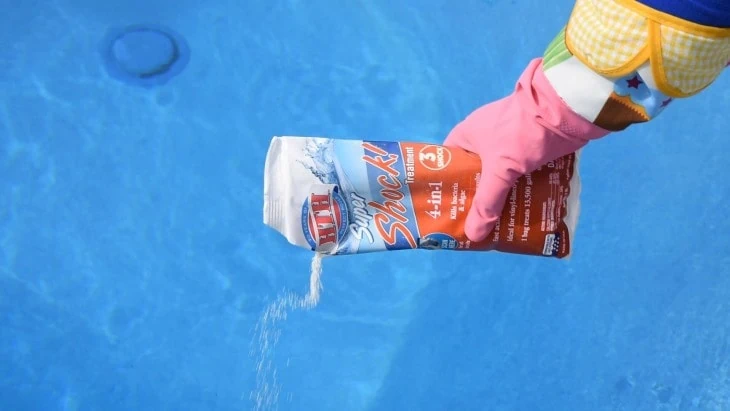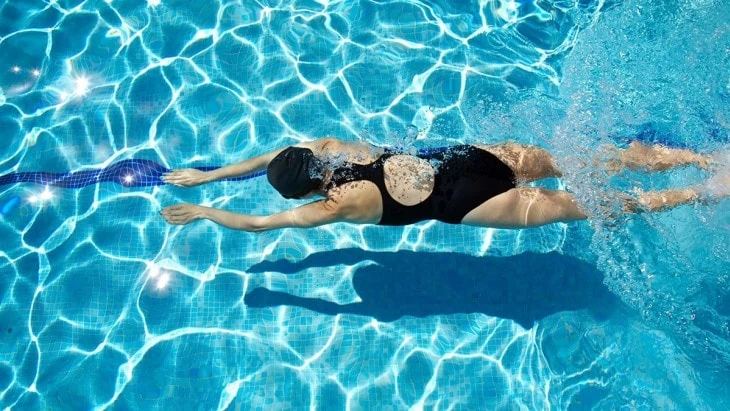If you’re looking forward to jumping in your pool at the end of a long workday or on a hot summer day, it’s going to be very disappointing to find your pool a shade of green. Green pools are pretty gross, and not many people are brave enough to swim in them. Luckily, it is pretty easy to determine why your pool is green and how to fix it.
Pools typically turn green when algae begin to grow in them. By maintaining proper chemical balance within your pool and by using shock to kill algae, it is fairly easy to keep your pool that beautiful blue color that everybody wants to see in their pool.
While light green pool water is fairly safe to swim in, darker greens mean that you should not get in your pool because algae can carry bacteria like E. coli, which makes humans sick.
Table of Contents
Why is My Pool Water Green?

Green pool water is almost always caused by algae overgrowth. While algae is an important part of a natural ecosystem and is present in most ponds and lakes, you probably don’t want it in your pool. Algae is the main reason that we shock pools and use sanitizer chemicals to clean them.
Algae can turn a pool light green in as little as a day if the pool has not been treated with the proper chemicals at the proper times. Algae can also damage pool filters and stain the insides of pools, making them look pretty nasty.
Above all, algae makes a pool slimy and no fun to swim in. Nobody wants their pool to be green and full of slime. Therefore, algae is something that should be prevented in pools.
What Makes Algae Grow?
Algae feed on decomposing materials, which means that if you have rotting sticks or leaves floating in your pool, it could be the reason that you have algae growing in your pool. They also need sunlight to survive, so if your pool is not covered with a pool cover, this will encourage algae to grow as well.
Algae grow best in pools with low levels of chlorine, because chlorine kills algae. If your pool’s chlorine levels are too low, they will grow quickly.
How Do You Fix Green Pool Water?
Skim and Remove All Debris From Your Pool

The first step in cleaning your pool and getting rid of algae is to simply skim the top of the pool and remove any large debris at the bottom of the pool. Things like leaves and sticks often fall into pools and can clog the pool’s filter, which means we’ll need to be working properly to clean the pool entirely.
Sticks and leaves also encourage algae to grow because the algae feed on decomposing materials, so it’s important to remove all of the debris in the pool before moving on to the next steps.
Test Your Pool’s Chlorine and pH Levels
Before we move on, it’s important to know where the pool’s chlorine and pH levels are at. Use a testing kit to determine your pool’s chlorine levels and pH levels. It’s essential to know these levels so that you can use the appropriate chemicals in your pool.
Fix the Pool’s pH Level
As we discussed above, you’ll need to test your pool’s pH levels. Your pool should be somewhere between 7.2 and 7.6 pH if it is healthy, while a pH of 7.7 or higher indicates a problem. If your pH is high, you can use sodium bisulfate to lower it.
To use sodium bisulfate in its powder form, simply read the instructions and determine how much sodium bisulfate to use based on your pool’s pH level. Then, pour the powder around the walls of the pool and wait for it to dissolve.
It can take more than six hours for sodium bisulfate to work its magic, so stay out of the water while you wait. After six hours, you can retest your pH levels to see if they fall between 7.2 and 7.6 this time. If they are still high, you can repeat the process using more sodium bisulfate.
Use Pool Shock

After fixing your pool’s pH levels, the next step is to use chlorine shock to kill any algae that could be present in your pool. Again, you’ll want to use a testing kit to test your chlorine levels, which should be between 5 and 10 parts per million.
If your chlorine levels are lower than five parts per million, which they likely will be if you have algae growth, you’ll need to use chlorine pool shock to clear out the algae. Pool shock is easy to use, so just follow the instructions on the package to determine how much to use and how long to wait before swimming.
Filter the Water
After adding sodium bisulfate and pool shock to your water, you’ll want to pump and filter the water. Simply turn your pool’s pump on and leave it on for at least a day. This will filter out all of the leftover algae and other debris in the pool.
How Do You Prevent Green Pool Water?
The best way to prevent green pool water is to stay on top of your sanitizing and shocking regimen for your pool. It’s important to shock your pool at least once a week to ensure that it stays clean and clear. Using sodium bisulfate whenever your pool’s pH is off will also help prevent green pool water.
Another important part of cleaning your pool is simply skimming and vacuuming your pool once a week to keep it clear of debris. Use a pool skimmer and pool vacuum to remove all of the excess debris that may land in your pool over the week. You can also buy a pool cover to help reduce the amount of debris that finds its way into your pool during the week.
Is It Safe to Swim in a Pool After Shocking It?

It is not safe to swim in a pool immediately after putting shock in the pool. You should wait at least twenty-four hours after shocking a pool before swimming in it. Ideally, you should test your pool for chlorine levels and wait until they are below five parts per million before you swim.
Is It Safe to Swim in Green Pool Water?
Depending on how green your pool water is, it may be fairly safe to swim in. Light green pool water typically does not contain large amounts of algae, making it generally okay to swim in.
However, if your pool water is a darker green, it is probably not safe to swim in, as algae can carry bacteria such as E. coli that can make humans sick.
The best option if your pool water is green is to not swim in it until you have shocked your pool and filtered it.
You should test your pool water for pH levels and chlorine levels to make sure that they are correct before you swim. The pH of the pool should be between 7.2 and 7.6 and the chlorine levels should be around five parts per million.

